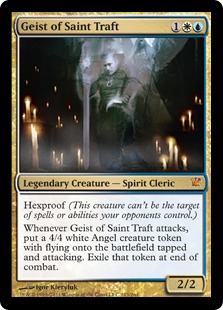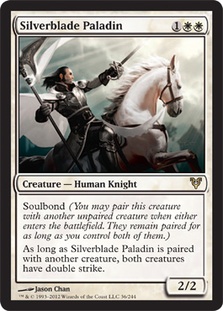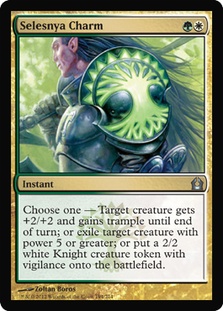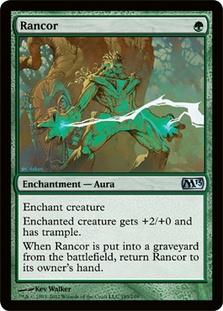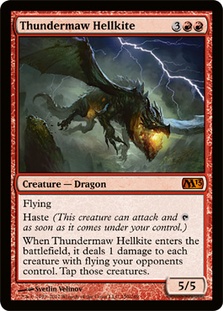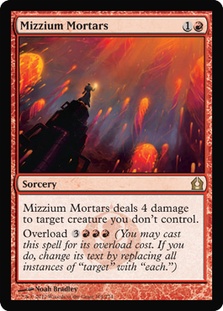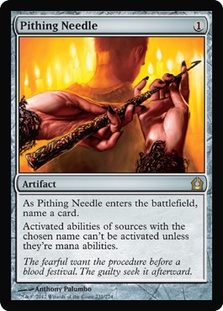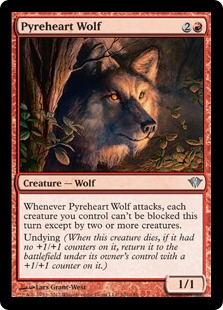Hello and welcome back! In today’s article, I am going to talk about my experiences at Grand Prix Atlantic City last weekend. In particular, I’d like to go over some do’s and don’ts of preparing for a tournament.
Currently, I am in a car en route from Atlantic City to Michigan with Michael Jacob, Jon Johnson, and Kim Logie. I’ve never had a laptop with enough battery life to last longer than twenty minutes, so getting to borrow one to write in the car is a fantastic treat for me because I get to write about my weekend while it is still fresh in my mind.
First of all, here is the deck that I played in the GP this past weekend. I got bit and caught:
Creatures (28)
- 4 Diregraf Ghoul
- 4 Gravecrawler
- 4 Falkenrath Aristocrat
- 3 Knight of Infamy
- 2 Thundermaw Hellkite
- 4 Dreg Mangler
- 4 Lotleth Troll
- 3 Thrill-Kill Assassin
Lands (24)
Spells (8)

I have never in my life seen a decklist that looked so good to me on paper but played out so poorly. The Zombie deck is full of cards that seem powerful and have a lot of synergies together, yet it didn’t perform very well for me.
I started out 4-0 (with three byes) and then proceeded to lose the next five rounds to finish out 4-5 (but technically in matches actually played I was a dreadful 1-5!).
Because when you catch Zombie Fever, you die…five times…
My matchups were:
U/W Flash, Win 2-1
Naya Midrange (feature match), Loss 0-2
Mono-Red Aggro, Loss 1-2
Four-Color Staticaster, Loss 1-2
U/W/R Flash, Loss 1-2
U/W/R Flash, Loss 1-2
All in all, it was not a very good tournament for me. Mike Jacob also played the identical 75, and though he did better than I did with a record of 6-3, he also failed to make Day 2.
Pro Tip #1: No Sleep = No Win
One of the easiest things a player can do to improve their chances of performing well at a tournament is to GO TO BED the night before. Sleep is important, and our brains require rest to properly function, especially to perform all of the complicated calculations and high stress decisions we need to make during the course of a long card tournament.
I did not heed this important piece of advice and suffered the consequences, as I am very aware that I made multiple small and avoidable mistakes that cost me matches. In one of my matches, I tried to sacrifice a creature to regenerate my Lotleth Troll, much to the confusion of my opponent (how embarrassing)! When one is playing deprived of sleep and sacrificing a creature to regenerate a Lotleth Troll, it is pretty needless to say that MANY mistakes will be made throughout the day.
Sleeping is good, and I highly recommend it.
In the days leading up to the Grand Prix, I talked to eventual GP Atlantic City Top 4 player Ari Lax about playing his Mono-Red Aggro list and was pretty sure I wanted to play it in the event. Also, Jon Johnson (one of the guys in our car) was raving about the Bant Hexproof deck (popularized on Magic Online by Michael Jacob, who was also in the car with me for ten straight hours) the entire car ride down, and I didn’t play that either. So I had information about three of the decks that ultimately made Top 4 of the event and decided not to play them. Why?
Initially, I was dismissive of the Hexproof deck largely because I didn’t bother to play with or against it. I felt it was gimmicky, had bad mana, and that it would only good if people didn’t know about it. WRONG! It turned out to be the breakout story of the Grand Prix, with two copies of the deck duking it out in the finals.
Once the tournament started and I got to watch people play games with the Bant deck, it was pretty clear that I had misjudged it. Hexproof wasn’t a deck that threw a Rancor on an Invisible Stalker and attacked seven times—it played Geist of Saint Traft and killed people really fast. As it turns out, Hexproof was an actual, viable combo deck!
"A fun Magic card to play against…"
Without Phantasmal Image in the format to keep this wily Spirit in check, there are not many ways in Standard to deal with him. Also, when people consistently play him on turn 2 or 3 and then give him first or double strike, or pump him, or jump him, it is very difficult to survive Innistrad’s "Ghost with the Most." The problem lies in the fact that the most reasonable way to interact with Geist is to simply block him and trade with him in combat. When a player is pumping or giving him evasion, that entire tactic goes right out the window as an answer.
"An unlikely combo enabler."
Silverblade Paladin is one of the cards that really impressed me in the deck, as for a fairly small investment it is capable of producing gigantic clumps of damage. When coupled with a pump spell that also provides trample, one attack is often all it takes to finish off an opponent.
"Selesnya smash!"
Pro Tip #2: Don’t Dismiss Until You Have Played With or Against It
If I had bothered to play three games with the Hexproof deck, I would have played it in the tournament.
Not dismissing new or off the wall ideas is usually something that I am pretty good about, and I wonder how much "not liking" Invisible Stalker and Geist of Saint Traft as cards actually played in my decision to ignore the Bant deck. If it influenced any amount in my decision, even subconsciously, that is too much because liking or not liking specific cards or styles of decks is usually a bad criteria for choosing a deck to play in an event.
My decision to not play Ari’s Mono-Red Aggro deck, in retrospect, was also pretty silly and unjustifiable. I thought that Mono-Red was well positioned, was confident that Ari’s list was well tested, and was set on playing it the day before. On Friday night, I started looking over Mono-Red, B/R, and Jund decks and thought maybe a hybridization of them might work out really well. Which brings me to:
Pro Tip #3: 2 AM Is No Time to Brew
When we are tired, we make bad decisions. First of all, late night pre-tournament brewing deprives us of precious sleep. Granted, sometimes people are snoring so loudly that sleep seems impossible, and in those moments brewing may seem like a productive use of one’s time—but it isn’t. The other problem is that there simply isn’t enough time to test these new and exciting ideas. Play something that has weight to it and has some evidence to support it doesn’t suck.
Or, as Jon Johnson just pointed out, "Has proven it can win more than one round at a GP, snicker, snicker…"
In theory, what I was trying to accomplish with Zombie Fever was to build a B/R deck that was very much like Red Sligh but also like Jund in the sense that the cards are individually good in and of themselves. It seemed like a good idea in theory. "The speed of Mono-Red Aggro with the card quality of Jund," yet in practice, my deck actually had neither the speed of Mono-Red nor the card quality of Jund.
Late night brew for the loss.
Good decks rarely ever come out looking good on the first try—it takes time to figure out what the right cards are and in the correct quantities.
If I’d had more time to rebuild and play some games, my deck might have been improved to look like this:
Creatures (26)
- 4 Diregraf Ghoul
- 4 Gravecrawler
- 3 Falkenrath Aristocrat
- 2 Geralf's Messenger
- 3 Knight of Glory
- 4 Dreg Mangler
- 4 Lotleth Troll
- 2 Thrill-Kill Assassin
Lands (24)
Spells (10)
Sideboard

I don’t actually think this deck is as bad as it performed for me, and in all honesty my tired play may have cost me more games than the my deck. Either way, I believe that the changes I’ve made are all to the benefit of the deck.
Notably, Thundermaw Hellkite was really bad for me because I had a lot of trouble casting him. He’s expensive, and I often couldn’t consistently acquire double red for his cost if I’d needed to play a Cavern of Souls earlier in the game naming something else. Most of the time, I discarded him to my Lotleth Troll, which was pretty miserable.
"Dragons are a Lotleth impressive when they are merely Battlegrowths."
The problem with the original list was that it was trying to do too many things at the same time. Mono-Red Aggro isn’t good because it has high-quality cards, and that was the mistake I made in building this deck for the tournament. It is difficult, to say the least, to maintain the consistency and resiliency of Sligh when splashing two colors. I often stumbled with my mana and lost valuable windows to exploit advantages in tempo.
The other thing I noticed was that cards that "upped the card quality" also cost me in regard to raw speed and closing power. For instance:
"Spells you can’t point at your opponent."
Being someone who doesn’t play a lot of red decks, I poorly framed what was to be valued about specific cards I selected for my deck. For instance, Mizzium Mortars can always kill an opponent’s Loxodon Smiter and for 3RRR dome their team. While those modes do offer a lot of flexibility, one form of versatility it didn’t afford me was the ability to light my opponents on fire via direct damage. As a player who tends to play control or midrange decks, I very much underestimated how important closing games with burn spells could be.
With my classier creatures and more "versatile" removal, I reasoned that needing burn to close out games would be less of an issue. Not true—only having to deal twelve points of damage with creatures because an opponent played a shockland and I have six points of burn in hand is a really big deal and can’t be understated.
Another thing that people trying to play aggressive decks in Standard need to take heed of is that Izzet Staticaster is a huge problem. Before the tournament, I thought about playing Pithing Needle but ultimately dismissed it. As it turned out, I played against decks with four Izzet Staticasters in half of my rounds and couldn’t beat the card. I really regretted not having Pithing Needle against U/W/R and especially against the Nightshade Peddler deck. My assumption was that in an aggressive deck using a card and tempo to play an artifact that didn’t deal damage would be wasting a card, but in reality, it would have fit right in with my Mizzium Mortars and Ultimate Prices as very good cards that don’t deal damage.
"What Izzet going to name? Olivia, obv."
Pithing Needle was basically the card that I wanted to have access to the most over the course of the tournament, which leads me to believe that other people just like me who don’t want to get crushed by Staticaster might also want to play with it.
So that is the story of how I went one level too deep and brewed up a Jund Zombie deck in the wee hours of the night before Grand Prix Atlantic City that didn’t commit deeply enough to an aggressive plan to be a good red deck. Oftentimes, card quality isn’t as important as synergy and positioning. What makes Mono-Red Aggro good isn’t that it is full of fantastic cards; on the contrary, its individual cards are often mediocre on their own (Stonewright, Pyreheart Wolf, Frostburn Weird), but it doesn’t matter because the whole point of the deck is to be as aggressive as possible. If your opponents are on the brink of death on turn 4 or 5 every game, they don’t necessarily have time to extend the game and take advantage of their higher-quality cards.
"Who are you calling mediocre!"
Unfortunately, this is exactly what happens when one brews up a deck in the middle of the night and then plays it without any testing. It is also what happens when one doesn’t take advantage of the amazing decklists that are gifted to him by friends and instead stubbornly (and unnecessarily) goes too deep into the tank.
Pro Tip #4: Don’t Reinvent the Wheel
If you are like me, and in my experience many Magic players are, we both really want to win and are willing to go to a lot of trouble to improve our chances of winning. In most cases, a little elbow grease goes a long way and is a good thing; however, sometimes it isn’t. Sometimes it is possible to try to do too much or go too deep into the tank.
Going too deep into the tank is when in order to solve problems or perceived problems, we go to extreme lengths to fix problems that are not really problems or solve problems in unrealistic ways. The real problem is often that because we want to figure out how to fix bad matchups and to prepare for every contingency, sometimes we forget that certain decks are just bad match ups, etc.
For instance, an imaginary slow control deck has a bad matchup against a very fringe aggressive red deck, and instead of accepting that the deck has a bad matchup, we use our entire sideboard to be 40% post-sideboard so we don’t "auto lose" to it. Using all of that space and becoming worse against everything else isn’t worth essentially "losing less badly" to the red deck.
In the case of my Zombie deck from the GP, I "solved" the problem of Mono-Red Aggro having objectively low-quality cards by making my deck much slower, much less consistent, and adding two colors. Why do really terrible ideas always seem so appealing at 5 AM?
I’m pretty exhausted and should probably get some ZZZZZs.
From a car somewhere in Pennsylvania, cheers and thanks for reading.

